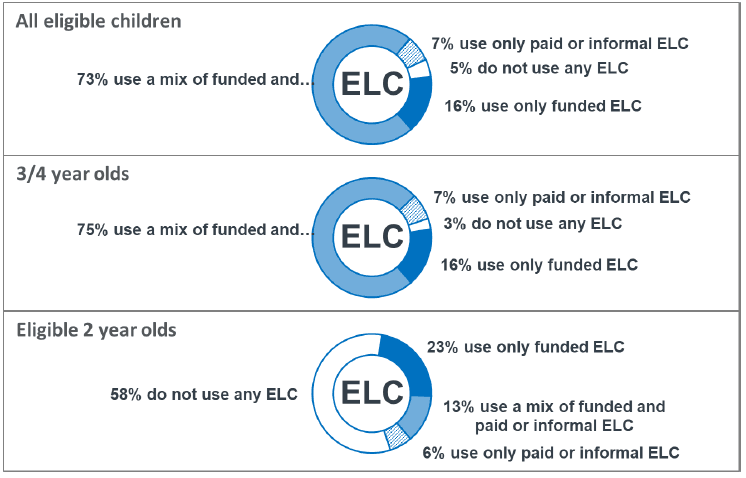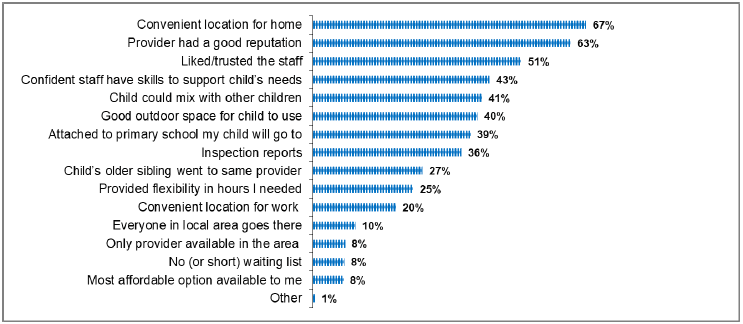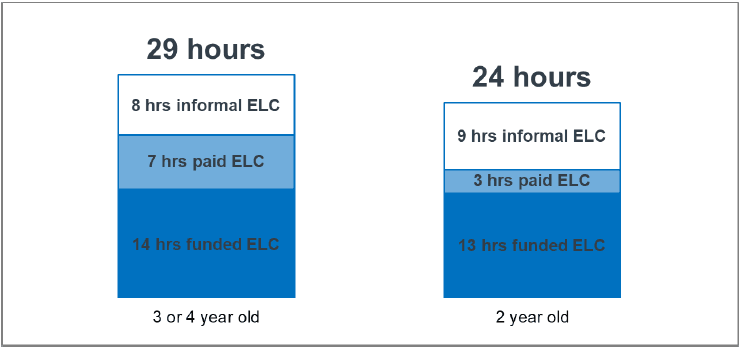Parents' views and use of early learning and childcare: report 2017
Information on parents’ and carers’ current use, future potential use, views and experiences of early learning and childcare.
This document is part of a collection
Use of Early Learning and Childcare
Uptake of the funded entitlement will be a key factor in the ELC expansion policy achieving its long-term aims. Funded hours are offered to all 3 and 4-year olds in Scotland, and to eligible 2-year olds. This section considers parents' current use of ELC, and factors that influence their use of ELC.
Survey data indicated that the great majority (95%) of parents with eligible children use some form of ELC. This overall level of uptake was consistent across most parent groups.
Parents with eligible children are diverse in the mix of funded, paid and/or informal ELC they use. Nearly 9 in 10 (88%) use some form of funded provision, but most combine this with paid and/or informal provision; 16% use only funded provision, and 73% used funded hours with paid and/or informal ELC. In terms of how this 73% of parents mix their funded hours with other options, 31% combine this with paid and informal provision, 21% with paid provision only, and 21% with informal provision only.
There was some variation in use of ELC linked to the age of the eligible child. Parents with an eligible 3 or 4-year-old are more likely to use funded or unfunded ELC (97% compared to 42% of those with an eligible 2-year-old), and are also more likely to use paid and/or informal provision. In contrast, where parents with an eligible 2-year-old are using ELC, they are more likely to use only funded hours.
Figure 3: Parents use of ELC (those with eligible children)

Around 1 in 10 (12%) parents with eligible children indicated that they do not use any of their funded entitlement. Some parents indicated they had made a choice not to use their entitlement, most commonly because they felt their child is too young or they preferred to look after their child themselves. Others mentioned barriers that had prevented them from using their entitlement, the most common being a lack of awareness of funded childcare and a lack of flexibility or choice in opening hours or childcare settings.
Figure 4: Most frequently mentioned reasons for not using any funded ELC (with eligible children)
| For eligible 3 or 4-year olds |
For eligible 2-year olds |
|---|---|
| Not aware of availability of funded childcare (21% of those not using) I think my child is too young (20%) I want to look after my child myself most of the time (16%) No reason/I don't know (15%) Lack of flexibility/choice in opening hours (14%) or childcare settings (13%) Don't know how to apply for funded childcare/find applying too difficult (14%) No available providers near me (14%) |
I think my child is too young (24% of those not using) Not aware of the availability of funded childcare (22%) No reason/I don't know (22%) No available providers near me (21%) Lack of flexibility/choice in opening hours (19%) or childcare settings (16%) I want to look after my child myself most of the time (16%) |
Note: Parents could select multiple options.
As noted in the next section of this report, a lack of flexibility in the hours and days of ELC available was highlighted as a key factor for parents being able to make full use of their funded entitlement. This included examples of parents being unable to use local authority nurseries unless they have access to informal childcare or are able to pay for private provision as wraparound.
Parents also highlighted some difficulties using their funded entitlement with private providers, primarily related to a lack of information on which private providers accept funded hours. This included a small number of parents who were unaware that this was an option. Parents also noted a lack of information on how different providers deal with funded hours, and for example whether parents are required to pay the full ELC cost in advance. Several parents highlighted this as a key factor in whether they can afford to use their funded entitlement with a private provider.
Parent G has a 4-year-old and a 2-year-old. The 4-year-old has been offered 30 hours per week of funded provision with a local authority nursery (Parent G lives in an area where the expanded entitlement is being piloted), but a lack of flexibility in the length of session each day means that this cannot cover Parent G's working day without access to informal or private ELC. Access to suitable ELC for the 2-year-old has been much easier – Parent G uses a childminder who provides high quality ELC, can cover working hours and offers additional flexibility.
Parents also referred to a lack of information on which funded providers have places available. Several parents suggested a need for centralised information to help parents find and access a suitable provider that accepts funding, including detail on the registration process and how parents can maximise the likelihood of securing a suitable place.
Key drivers of parents' use of ELC
Survey data indicated that use of funded, paid and informal ELC varies across key parent groups. Regression analysis has been used to identify the factors that have the greatest impact on the mix of funded, paid and/or informal ELC currently used by parents.
Results for all parents show that the number of hours used and the amount spent on ELC have the closest correlation with parents' use of funded, paid and/or informal ELC. Those who use less than 16 hours per week are more likely to use only funded hours, and those who pay less are more likely to use some form of funded provision. Other key points of note are:
- Those with eligible children are more likely to use funded provision, and those without eligible children are more likely not to use any ELC.
- Two earner households are more likely to use paid provision, and those with fewer than 2 adults in employment are more likely to use only funded provision.
- Those with additional children aged 6+ in the household are more likely to use only funded provision.
Figure 5: Factors having a significant impact on mix of funded, paid, informal ELC
| Most significant drivers |
Number of hours of ELC currently used Current spend on ELC |
|---|---|
| Other factors showing a significant correlation |
Whether parents have eligible children Number of adults in employment Number of children in household/whether includes children aged 6+ Household income Whether living in deprived area Age of parent |
Choosing a provider
The survey also asked about the type(s) of ELC provider that parents currently use.
Local authority nurseries were identified as the most commonly used type of provider; 67% of those with an eligible child use this type of provision, most of these being linked to a primary school (55%). Private nurseries are also used by a substantial proportion of those with an eligible child (42%). In addition, 13% use a playgroup, and 13% a childminder.
Figure 6: Types of ELC provider used (those with eligible children)

Note: Parents could select multiple options.
Parents' choice of ELC provider was influenced by a range of factors, with convenience of location and the provider's reputation the most common (each were mentioned by around two thirds of parents with eligible children). Providers' staff were also a common factor, including whether parents like and trust staff (51%) and staff having the skills to support their child's needs (43%). Other common factors included children being able to mix with others (41%), good outdoor space (40%), links to the primary school that the child is expected to use (39%), and the content of inspection reports (36%).
Figure 7: Factors influencing choice of ELC provider (with eligible children) [8]

Note: Parents could select multiple options.
Hours of ELC used
The survey asked about the number of hours of ELC that parents use for each of their eligible children. Responses indicated that parents on average use 29 hours of ELC per week for an eligible 3 or 4-year-old, and 24 hours per week for an eligible 2-year-old. This suggests that parents on average use around 20% fewer hours (funded and non-funded) for an eligible 2-year-old, than for an eligible 3 or 4-year-old. [9]
In terms of the types of ELC used, the survey indicated that for 3 or 4-year olds, parents use an average of 14 funded hours of ELC per week, 7 paid hours and 8 informal hours. For eligible 2-year olds, parents use an average of 13 funded hours, 3 paid hours and 9 informal hours. This indicates that there is little difference in the number of funded hours used for 3/4-year olds and eligible 2-year olds. However, parents typically use more than twice as many paid hours for 3/4-year olds than for eligible 2-year olds, while eligible 2-year olds are more reliant than 3/4-year olds on informal hours as a proportion of the total hours used (38% of the average hours for 2-year olds, compared to 28% for 3/4-year olds).
These results also indicate that most of those using funded provision are making use of their full entitlement, with around 4 in 5 (79%) using 15 or more funded hours per child per week. Nevertheless, there remained 13% who use less than 10 funded hours per child per week.
Figure 8: Average weekly mix of hours of ELC per child (with eligible children)

Survey data indicated that the number of hours of ELC currently used varies across key parent groups, and regression analysis has been used to identify the factors that have the greatest impact.
Results show that the mix of funded/paid/informal ELC used, whether parents pay for ELC, whether the household includes additional children aged 6+, and parents' current spend on ELC have the closest correlation with the number of hours of ELC used. In particular, those using paid ELC typically use more hours per week while those using only funded provision typically use fewer hours. Those paying a total of £500 or more a month typically use more hours of ELC, and those with children aged 6+ typically use fewer hours per week.
Figure 9: Key drivers of number of hours of ELC currently used (3/4-year olds)
| Most significant drivers |
Whether parents use funded, paid and/or informal provision Whether parents currently pay for ELC Number of children in household/whether includes children aged 6+ Current spend on ELC |
|---|---|
| Other factors showing a significant correlation |
Number of adults in employment Household income |
Views and experiences across parent groups
The research identified some significant variation across parent groups in use of ELC and factors influencing use of ELC.
This variation primarily related to income, deprivation and whether parents pay for ELC. For example, lower income households, single earners and those in the most deprived areas use less hours of ELC on average, were more likely to use funded hours and less likely to pay for ELC. In contrast, those who pay for ELC use more hours of ELC on average, and were more likely to use private nurseries or childminders.
Below we summarise the main variations across parent groups, highlighting where parents were significantly more or less likely than those in other parent groups to give a specific response.
| Low incomes/Most deprived areas |
Less likely to use ELC. Those that do use ELC are more likely to use funded hours, less likely to pay, less likely to use a private nursery, and use fewer hours on average. Less likely to base their choice of ELC provider on inspection reports, good outdoor space, convenient location for work, and flexibility of hours. |
|---|---|
| Rural areas |
More likely to use a local authority nursery or playgroup. |
| Single earner households |
More likely to use only funded ELC and local authority nurseries, and less likely to pay for ELC or to use private nurseries. Use fewer hours of ELC on average. |
| Parents of children with ASN |
More likely to use funded ELC, less likely to pay for ELC and less likely to use private nurseries. Use fewer hours of ELC on average. |
| Currently pay for ELC |
Less likely to use funded ELC and local authority nurseries, more likely to use private nurseries and childminders. Use more hours of ELC on average. More likely to base their choice of ELC provider on reputation, flexibility of hours, convenient location, good outdoor space, and inspection reports. |
| Do not currently use funded ELC |
More likely to use private nurseries or childminders. |
| Other significant differences |
Parent age: Under 30s are less likely to use ELC. Those that do use ELC are less likely to pay or to use private nurseries, are more likely to use local authority nurseries, and use fewer hours on average. Parent gender: No significant variation. Parents who also have school-age children are less likely to use private nurseries. Parents who do not pay for ELC are more likely to base their choice of ELC provider on the setting being linked to the primary school they expect to use. |
Contact
There is a problem
Thanks for your feedback